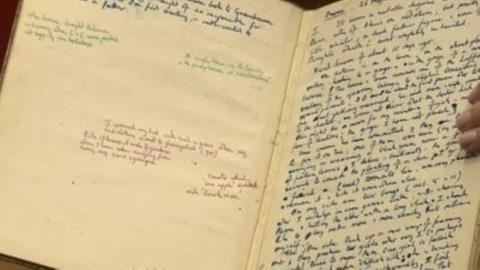- MENU
- HOME
- SEARCH
- WORLD
- MAIN
- AFRICA
- ASIA
- BALKANS
- EUROPE
- LATIN AMERICA
- MIDDLE EAST
- United Kingdom
- United States
- Argentina
- Australia
- Austria
- Benelux
- Brazil
- Canada
- China
- France
- Germany
- Greece
- Hungary
- India
- Indonesia
- Ireland
- Israel
- Italy
- Japan
- Korea
- Mexico
- New Zealand
- Pakistan
- Philippines
- Poland
- Russia
- South Africa
- Spain
- Taiwan
- Turkey
- USA
- BUSINESS
- WEALTH
- STOCKS
- TECH
- HEALTH
- LIFESTYLE
- ENTERTAINMENT
- SPORTS
- RSS
- Books & Book Reviews

Alan Turing, the British mathematician and computer scientist who is considered to be the father of theoretical computer science and artificial intelligence, kept a handwritten notebook during World War II while he was working at Bletchley Park, the British government's code-breaking center. The notebook contains Turing's mathematical and computer science notations, as well as his thoughts on the nature of computation and intelligence.
The notebook was sold at auction in 2015 for $1 million at Bonhams in New York.
It is now on display at the National Museum of Computing in Bletchley Park.
The notebook is a valuable resource for historians and computer scientists. It provides insights into Turing's thinking on a wide range of topics, including the design of computers, the nature of computation, and the possibility of artificial intelligence.
Here are some of the things that Turing wrote in the notebook:
He developed the concept of the Turing machine, a theoretical model of computation that is now considered to be the foundation of modern computer science.
He proposed the Turing test, a test of a machine's ability to exhibit intelligent behavior.
He explored the possibility of creating artificial intelligence, a field of computer science that is now widely studied.
Turing's work on the Turing machine and the Turing test had a profound impact on the development of computer science. His work on artificial intelligence is still being studied and debated today.
The handwritten notebook by Alan Turing is a priceless historical document. It is a testament to Turing's genius and his contributions to the field of computer science.
Book Reviews: "Alan Turing's Handwritten Nazi Codebreaker Notebook"